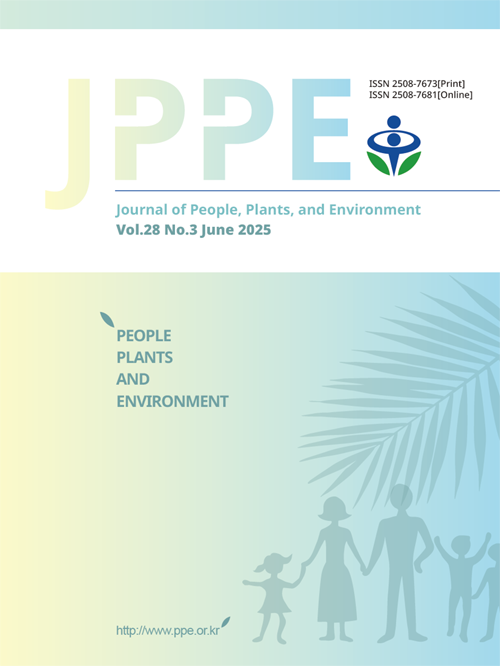학술논문
A Study on Mortality Rate a nd Resprouts Growth in the Early Period after Planting of Quercus acutissima Carruth
이용수 49
- 영문명
- 발행기관
- 인간식물환경학회
- 저자명
- Ji-yu Choi Ye-rim Jang Boyoung Kim Seung-yeon Yu Dong-gil Cho
- 간행물 정보
- 『인간식물환경학회지(JPPE)』제28권 제3호, 339~357쪽, 전체 19쪽
- 주제분류
- 자연과학 > 자연과학일반
- 파일형태
- 발행일자
- 2025.06.30

국문 초록
Background and objective: Although the use of seedlings/saplings is recommended in ecological restoration projects, inpractice, mature trees are more commonly planted. Therefore, this study was conducted to examine the potential of usingsaplings in ecological restoration. The primary goal is to experimentally evaluate the feasibility of sapling-based plantingtechniques, which are recommended for ecological restoration projects. The findings of this study are expected to serveas foundational data for developing more efficient ecological restoration methods and guiding future managementstrategies.
Methods: A total of 132 saplings of sawtooth oak (Quercus acutissima Carruth.), a species commonly used in ecologicalrestoration, were planted across 36 quadrats. Over a period of approximately 29 months, mortality rates and the growth ofresprouts from dead trees were investigated and analyzed.
Results: An analysis over 29 months revealed that the overall mortality rate was 42% in the first year of planting, 44% at18 months, and 37% at 29 months. The proportion of dead saplings that produced resprouts was 0% for R2-sized saplings,27% for R4, 19% for R6, and 20% for R8. Additionally, the average number of resprouts per tree was 2.5 in non-mulchedplots, 4 in 5-cm mulched plots, and 1 in 10-cm mulched plots. An integrated analysis of experimental plots—differentiatedby tree size, planting density, and mulching treatment—showed that medium-density plantings (13 trees per m2) of R2 andR4-sized saplings resulted in decreasing mortality rates with increasing mulch depth. On the other hand, low-densityplanting (0.2 trees per m2) of mature trees showed higher mortality rates regardless of mulch depth and exhibited lowerrates of resprouting.
Conclusion: For effective ecological restoration projects, priority should be given to planting saplings in a medium-densityconfiguration. However, as saplings cannot initially provide the broad canopy spread provided by mature trees, the use ofmulching materials, such as wood chips, is recommended to cover the ground layer. This can help stabilize early growthby retaining soil moisture and controlling weeds.
영문 초록
목차
Introduction
Research Methods
Results and Discussion
Conclusion
References
해당간행물 수록 논문
참고문헌
- Korean J. Environ. Ecol.
- Journal of Environmental Science International
- Nexus Environmental Design Research Institute Press
- Ministry of Environment academic service research report
- Ecological Engineering
- Nature Conservation
- Journal of Korean Society of Forest Science
- Korean J. Environ. Ecol
- Proc. Korean Soc. Environ. Ecol. Con.
- Journal of Environmental Science International
- Journal of the Korean Landscape Architecture Association
- Wonkwang University Life Resources Science Research
- J. Kore. For. En.
- Seoul National University Press
- Hyangmun Publishing
- Journal of the Korean Society of Ecology
- Korean J. Environ. Ecol.
- Forest Ecology and Management
- Scientific Reports
- Korea Rural Economic Institute Basic Research Report
- Plant Biotechnology
- Forest Ecology and Management
- Trees, Forests and People
- Hyangmun Publishing
최근 이용한 논문
교보eBook 첫 방문을 환영 합니다!

신규가입 혜택 지급이 완료 되었습니다.
바로 사용 가능한 교보e캐시 1,000원 (유효기간 7일)
지금 바로 교보eBook의 다양한 콘텐츠를 이용해 보세요!


